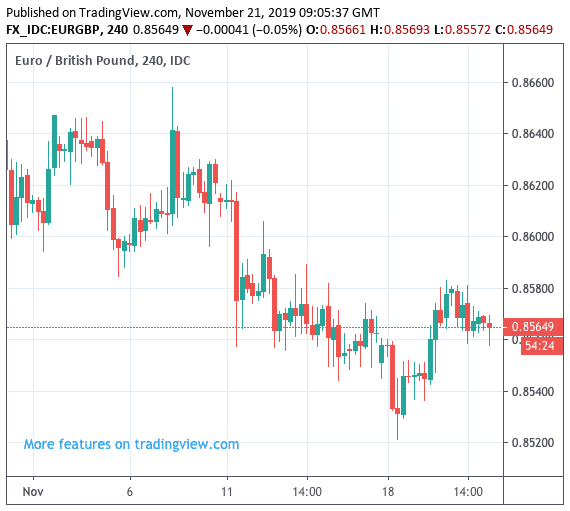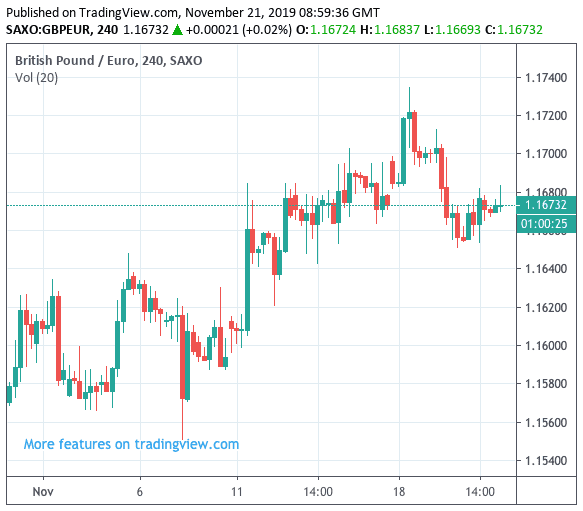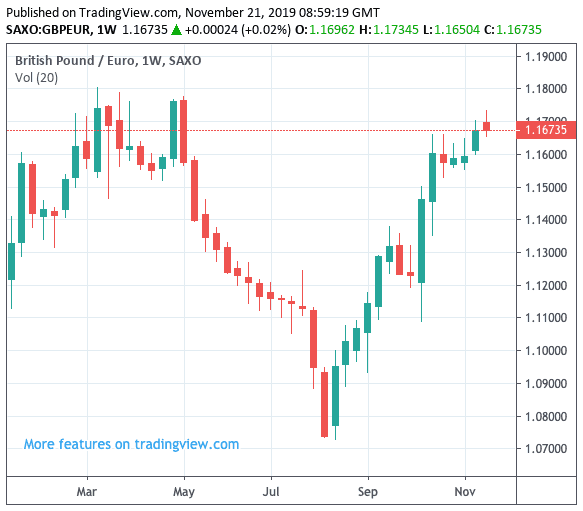Pound-Euro Exchange Rate Outlook: Risks to the Downside says Leading Technical Analyst

Image © Adobe Images
- EUR/GBP at 0.8565 today
- GBP/EUR at 1.1671 today
- Pound's recent rally against Euro fading
- But any Euro strength seen as short-term in nature
- Lloyds see potential for GBP/EUR to trade around 1.13 into election
Pound Sterling's multi-week advance against the Euro could be in the process of failing, and some declines in the short-term could be expected according to the latest studies of the EUR/GBP charts.
According to Karen Jones, Team Head FICC Technical Analysis Research at Commerzbank, the Euro could enjoy a short-term bounce against the Pound, as charts look to increasingly favour the Eurozone's single currency.
"Caution warranted," says Jones in a note to clients out Thursday, "EUR/GBP near-term risks are to the topside".
Above: EUR/GBP four hour chart shows the Euro has gained on the Pound since Nov. 18.
Above: Flipping EUR/GBP around to give the GBP/EUR four hour chart view shows 1.17 might have been a high water mark for now.
Jones has over 30 years of experience in technical analysis and has been voted in the top 5 positions for 10 years in the Euromoney survey and the Technical Analyst Awards.
"EUR/GBP has another 13 count on the daily chart PLUS divergence of the daily RSI and I think this will bounce near term," says Jones. "Rallies will find a minor downtrend at 0.8637 ahead of the 3 month downtrend at 0.8809. Resistance is reinforced by 0.8786 the mid-September low," says Jones.
The technical parlance in the above analysis will interest professional technical traders, however for those without any experience, the basic findings of the studies are ultimately what matters.
Jones' findings suggest that should the Pound fall, declines will find a potential target 1.1578 first, ahead of 1.1250.
Any weakness in Sterling would therefore be expected to target the above-mentioned levels, where they could fade.
Ultimately Jones maintains that any strength in the Euro against the Pound should ultimately be short-lived, and she says the team's current position on EUR/GBP is to hold "tiny longs at 0.8575". In GBP/EUR terms, this means holding small bets against Sterling at 1.1661.
The Pound has advanced against the Euro for 11 out of the past 15 weeks now, and these technical studies are saying another pause and reversal of part of that rally is possible, but the broader trend is one of Sterling strength that would be expected to remain in force over a longer-term timeframe:
Above: Sterling has been rallying since August, but pauses to the uptrend are frequent.
Time to move your money? Get 3-5% more currency than your bank would offer by using the services of a specialist foreign exchange specialist. A payments provider can deliver you an exchange rate closer to the real market rate than your bank would, thereby saving you substantial quantities of currency. Find out more here.
* Advertisement
Robin Wilkin, a cross-asset strategist with Lloyds Bank is also seeing the prospect of near-term weakness in Sterling, he says should GBP/EUR weakness result in a move back down through 1.1664, "it would suggest an extension towards more important" short-term support around 1.1520.
Any break through 1.1520 would in turn open the door to the Pound falling into a lower range against the Euro of 1.13, and Wilkin says this range should be held "into the election".
The British Pound has this week traded with a softer tone, with market focus remaining fixated on the December 12 General Election which is currently expected to deliver a Conservative Party majority.
With the Conservatives holding an advantage in the polls over the opposition Labour Party, all eyes were on the ITV head-to-head debate between party leaders Boris Johnson and Jeremy Corbyn for any stand-out performances that might shift the electorate's opinion.
Sterling is currently tracking the odds of a Conservative majority, showing a positive correlation with increased prospects of such an outcome, therefore a poor performance by Prime Minister Boris Johnson could well have triggered declines in the currency.
However, the debate went well for both leaders in the sense they both stayed on message and didn't slip up, an outcome encapsulated by a snap YouGov poll following the debate that showed the two leaders virtually split on perceived performance, with 51% of polled viewers judging Johnson to have won the debate, against 49% for Corbyn.
"Investors digested the first televised debate yesterday between Tory leader Johnson and Labour’s Corbyn. The debate was almost a tie, a poll showed, but offered little news to the public. Lack of data or other high profile (political) headlines resulted in technical, sideways range trading. If anything, Sterling marginally lost ground vs. the Euro," says Mathias Van der Jeugt, an analyst with KBC Markets in Brussels.
The next potential test for Sterling will be the release of the Conservative Party's manifesto. The release of the party's manifesto in 2017 coincided with a sharp drop in support for the Conservative's in the polls, that ultimately saw Theresa May eke through a 2% win in overall vote share against Labour.
Should such an outcome occur in 2019, this might well weigh on Sterling.
Perhaps conscious of the need to avoid a repeat of 2017, the Conservatives are yet to release its manifesto and they may only publish the full document two weeks before the General Election.
Instead, it will unveil individual policies at regular intervals throughout the campaign.
Time to move your money? Get 3-5% more currency than your bank would offer by using the services of a specialist foreign exchange specialist. A payments provider can deliver you an exchange rate closer to the real market rate than your bank would, thereby saving you substantial quantities of currency. Find out more here.
* Advertisement







